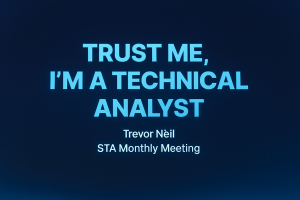Trust Me, I’m a Technical Analyst by Trevor Neil: Why Charting Is as Important Now as Ever
Trevor Neil, a veteran technical analyst, argues that charting remains essential in modern trading. While many analysts rely on fundamentals, most top performers quietly use technical analysis to time their trades. Charts help distinguish between genuine reversals and healthy pullbacks, providing nuance and preventing premature decisions.
Technical analysis is often mocked, but once understood, it offers clarity. Using just open, high, low, and close data, chartists read market behaviour—acceleration, exhaustion, reversal. The best technical analysis is simple and effective, with indicators like RSI still widely used because they work.
Trevor’s approach is systematic: scan for weekly MACD positivity and ADX above 30, then look for dips where daily RSI drops below 50 and volume declines. This isn’t prediction—it’s observing investor behaviour and acting on probabilities. Price reflects all market knowledge and emotion at any moment, often revealing truths models miss.
Chart patterns—head and shoulders, double tops—are visual representations of crowd psychology. Behavioural finance concepts like fear, greed, and herding are visible in price action. Algorithms now automate what chartists once did manually, but even machines carry human biases.
Technical analysis is especially valuable now due to three challenges:
- Information Overload: Charts simplify complexity and filter noise.
- Algorithmic Markets: Machines leave patterns in price, which TA can read.
- Behavioural Extremes: Events like meme stocks and crypto manias show how charts capture mass psychology objectively.
TA adapts instantly to market changes, providing early warnings and timing tools. It doesn’t judge fundamentals but tells you when to act. Professional TA is structured, disciplined, and integrates with quant, behavioural, and fundamental analysis.
Looking ahead, the future is AI-augmented and human-guided. AI helps scan markets and suggest strategies, but humans make decisions. The fusion of technical and fundamental analysis is key—long-term investors use fundamentals, short-term traders rely on timing, and the best use both.
Trevor’s conclusion:
“Technical analysis measures behaviour, not belief.”
Charts reflect how people react to facts, not just the facts themselves. In a noisy, volatile world, TA offers clarity and timing—the edge every trader needs.
Tags: ChartWisdom, PriceAction, QuantCharts, TimingEdge
The views and opinions expressed on the STA’s blog do not necessarily represent those of the Society of Technical Analysts (the “STA”), or of any officer, director or member of the STA. The STA makes no representations as to the accuracy, completeness, or reliability of any information on the blog or found by following any link on blog, and none of the STA, STA Administrative Services or any current or past executive board members are liable for any errors, omissions, or delays in this information or any losses, injuries, or damages arising from its display or use. None of the information on the STA’s blog constitutes investment advice.
Latest Posts
- Trust Me, I’m a Technical Analyst by Trevor Neil: Why Charting Is as Important Now as Ever October 15, 2025
- Why Networking Still Matters: Reflections from the STA Drinks at the National Liberal Club October 2, 2025
- Fireside Wisdom: Clive Lambert in Conversation with Tony LaPorta September 10, 2025
- Understanding Triple RSI Divergence: A Potential Warning Sign for the S&P 500 September 1, 2025
- Unlock Your Potential in Finance: Join the Society of Technical Analysts – No Qualifications Required July 24, 2025




















Latest Comments